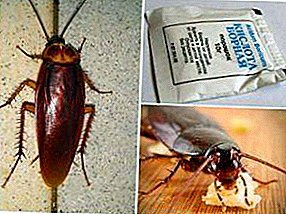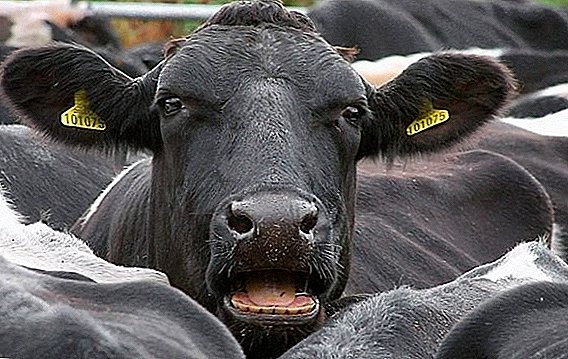 The causative agents of this disease, as small as a couple of microns, are capable of dumping a huge cow from the hooves. Fortunately, today, anaplasmosis is rarely fatal, but the parasites undermine the health of cattle thoroughly. Modern drugs in most cases can cure a sick animal, but treatment is accompanied by considerable financial and time costs, so the fight against the disease must necessarily be coupled with preventive measures that prevent the occurrence of the disease in the future. How to do this will be discussed further.
The causative agents of this disease, as small as a couple of microns, are capable of dumping a huge cow from the hooves. Fortunately, today, anaplasmosis is rarely fatal, but the parasites undermine the health of cattle thoroughly. Modern drugs in most cases can cure a sick animal, but treatment is accompanied by considerable financial and time costs, so the fight against the disease must necessarily be coupled with preventive measures that prevent the occurrence of the disease in the future. How to do this will be discussed further.
What is anaplasmosis cattle
This disease is caused by microorganisms whose size is between 0.2 and 2.2 microns. These creatures penetrate into the red blood cells and parasitize them. Anaplasms violate redox and metabolic processes, worsening oxygen transmission in animals.  As a result, anemia is observed in infected cattle.
As a result, anemia is observed in infected cattle.
Did you know? For the formation of 1 liter of milk through the udder of a cow must pass half a ton of blood. During the day, about 6 tons of blood is pumped through the mammary glands of a cow producing milk.
Pathogen, development cycle, sources and routes of infection
The causative agent of this disease is one of the types of intracellular bacteria, which are introduced into the erythrocytes, and sometimes into platelets and white blood cells. Parasites live in colonies and breed by budding or dividing.
Being transmissible, this disease needs carriers that are usually presented in the form of:
- mosquitoes;
- flies;
- ixodic ticks;
- gadflies;
- biting beetles;
- sheep bloodsucker;
- midges
It is not uncommon for cows to become infected with anaplasmosis by means of instruments on the surface of which was the blood of sick cattle.
Incubation period and signs of infection
Since the period of incubation of the disease lasts 6-70 days, an animal that has received an infection in the summer can also become ill with the onset of cold weather.  Inadequate or improper treatment, as well as inadequate livestock maintenance can lead to the fact that the infection can lurk in the organs of animals and then manifest itself almost all year round, not excluding the winter.
Inadequate or improper treatment, as well as inadequate livestock maintenance can lead to the fact that the infection can lurk in the organs of animals and then manifest itself almost all year round, not excluding the winter.
To infectious diseases of cattle include pasteurellosis, actinomycosis, abscess, parainfluenza-3.
However, most often the outbreaks of this disease occur in spring and summer during the maximum activity of carriers of infection.
Its signs are:
- elevated temperature of the animal;
- blanching of the mucous membranes;
- a sharp deterioration in appetite;
- depressed state;
- respiratory failure;
- accelerated heartbeat;
- the occurrence of cough;
- disruption of the digestive system;
- weight loss;
- cessation of milk production

Diagnostics
An accurate diagnosis of anaplasmosis is complicated by the fact that this infection is often associated with other diseases and is difficult to distinguish from them.
Most often, anaplasmosis can be confused with:
- anthrax;
- leptospirosis;
- piroplasmosis;
- theileriosis;
- babesiosis.
For an accurate diagnosis, they resort to laboratory studies, as well as to the study of the epizootic situation in the adjacent territories, time of year, and climatic conditions.
Serology methods are also actively used when antigen and antibodies are used to study a disease, and by analyzing their reactions, the disease is diagnosed. However, the study of a blood smear is still crucial in the diagnosis of anaplasmosis.
Did you know? Currently on our planet there are over a billion heads of cattle.
Sick and recovered cows acquire immunity, which is of short duration for a maximum of four months. But in calves that were bred by a cow that had been ill during pregnancy, anaplasmosis either does not occur at all, or takes a very mild form. 
Pathological changes
The representatives of the cattle who died from these parasites are observed:
- severe exhaustion;
- pallor and flabbiness of skeletal muscles;
- traces of hemorrhage;
- increase in spleen and gallbladder;
- signs of pulmonary emphysema;
- enlarged kidneys, lymph nodes and liver;
- turbid urine;
- subcutaneous edema.
The disease occurs in animals in acute and chronic forms, and the chronic course is easier. In acute form, the disease lasts up to a month, recovery does not occur immediately and is delayed for a long period.
Control and treatment
The pace and quality of recovery of diseased livestock depends on the speed and accuracy of diagnosing the disease and the correctness of timely treatment.
Isolation of sick animals
The diseased animal should be immediately removed from the herd, placed separately and, after an accurate diagnosis, subjected to intensive treatment.

Antibiotics and all kinds of drugs with a dosage and treatment regimen
Currently, there are proven methods of combating this disease and a complex of drugs that successfully fight parasites.
Diseases of cows that provoke parasites include cysticercosis, teliasiasis, and actinomycosis.
The following drugs are used for this:
- "Terramycin", "Tetracycline" and "Morfitsiklin", which are diluted in a two-percent novocaine solution and injected intramuscularly at the rate of 5-10 thousand units for each kilo of cow's weight. The drug is administered daily for 4-6 days.
- Oxytetracycline-200 is a long-term therapeutic agent that is administered intramuscularly once a day every four days.
- "Sulfapyridazin-Sodium", 0.05 g of which per kilogram of cow's weight is diluted in distilled water in a ratio of 1:10. The tool is introduced for three days once a day.
- "Biomitsin", which give the animal inside at a rate of 10 mg per kilogram of live weight every day for a week.
- "Ethacridine lactate", 200 mg of which is diluted in medical alcohol (60 ml) and distilled water (120 ml) and injected into a cow intravenously 1 time per day.
Important! When symptomatic treatment of cattle should be given antipyretic and analgesic drugs.
Water and green succulent feed in the diet
A cow that has become ill with anaplasmosis suffers from a disturbance of metabolic processes in the body, therefore a diet that is a banal juicy green is extremely important for her. There is no better food for a sick cow. In addition, plentiful drinking is very important for the recovery of the animal. 
Vitamin and mineral supplements
Since during the cold season, the development of anaplasmosis is provoked by vitamin and mineral deficiencies in cattle feeds, and the disease itself causes a disturbance of metabolic processes, which, in turn, further aggravates the deficiency of vitamins and minerals in the body, it is difficult to overestimate the importance of vitamin and mineral supplements feed animals in the form:
- calcium, phosphorus, vitamin D, the lack of which worsens the cow's appetite, makes the animal fearful and inhibits its growth;
- copper, which must necessarily be present in any balanced feed;
- vitamin A, manganese and cobalt, whose deficiency is fraught with inadequate digestion and exhaustion;
- zinc and iodine, the lack of which in the feed leads to a drop in milk production;
- vitamin E, whose deficiency leads to anemia and even dystrophy.
Important! Anaplasmosis is a serious disease, and preventive measures to prevent it should be similar.
Prevention
To the prevention of this disease fit in the complex, outlining a whole range of necessary measures:
- In a region with already noted foci of disease, animals are necessarily treated with anti-insect agents that carry this infection. First of all, it concerns ticks.
- Pasture with the same purpose undergoes special treatment.
- If this procedure is not possible, cows are weekly treated with anti-tick drugs.
- In a healthy herd, novices are allowed only after a month-long quarantine and after a guaranteed absence of symptoms of anaplasmosis.
- Every year, at least three times they carry out the decontamination of all the premises, yards with livestock, all the tools and equipment related to animal care.
- With the winter anaplasmosis that occurred in this region, cattle with the onset of cold weather add vitamins and minerals to the feed.
- It is recommended for cattle to be vaccinated against this ailment, which develops immunity in it for 10-11 months.
 Although this disease today does not cause a loss of livestock, the fight against it is very difficult, costly and time consuming. It is much easier to take preventive measures that reliably prevent the onset of this scourge.
Although this disease today does not cause a loss of livestock, the fight against it is very difficult, costly and time consuming. It is much easier to take preventive measures that reliably prevent the onset of this scourge.











